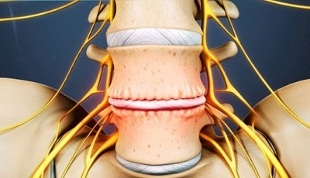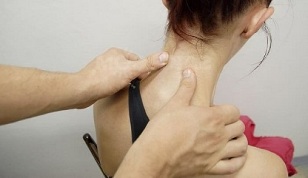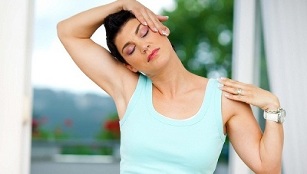Timely treatment of a disease can increase the chances of a quick and successful recovery. But in any case, it is better not to allow the development of a particularly serious disease, such as cervical osteochondrosis.
Definition of cervical osteochondrosis

Cervical osteochondrosis is a fairly common disease that has recently affected more and more young people. The disease affects the intervertebral discs in the cervical spine. Often the development of the pathological process of degenerative-dystrophic changes is facilitated, for example, by a wrong body position due to prolonged work on the computer.
Among other things, the problem can be caused by genetic predisposition, poor posture, restless bed rest and a sedentary lifestyle. Although this type of osteochondrosis develops very slowly, it tends to progress.
In elderly patients, this disease is mainly associated with other degenerative processes, for example:
- jaw arthrosis;
- spondylosis;
- uncovertebral arthrosis, etc.
symptoms
As for the most characteristic symptoms, first of all, it is possible to note the appearance of sharp pains caused by compression of nerve endings. The pain is often concentrated in the lumbar, cervical and lumbar regions. In addition, you can find other syndromes:
- heart syndrome- consists of several symptoms similar to angina pectoris. This syndrome develops during irritation of the large pectoralis muscle or the roots of the phrenic nerve. For this reason, a person experiences feelings of a depressing nature that can occur periodically in the area of the heart muscle and last for several hours. Sneezing or sudden head movements often exacerbate the pain. In addition, no changes in the cardiogram can be detected during painful attacks;
- radicular syndrome- occurs when the nerve endings in the cervical spine are compressed. At this point, there is pain that can be felt not only in the forearm, shoulder or shoulder blade, but also in the lumbar region. The patient may feel a slight tingling or more pronounced sensation, depending on how long the osteochondrosis has started;
- Irritant-reflex syndrome- manifests itself with burning pain in the occiput and neck. Such symptoms often occur after waking up, with sharp dizziness, coughing and sneezing. Moreover, the pain can manifest itself not only in the shoulder area, but also in the chest area;
- vertebral artery syndromeis one of the typical manifestations of the disease, characterized by burning or throbbing headache, which is more localized in the temporal or occipital region. It is a persistent pain that often occurs with this syndrome, but can sometimes occur and subside.
Attention!When there are signs of cervical osteochondrosis, experts note an increase in fatigue, which can lead to hearing and vision impairment.

As for the other main symptoms of the disease, they include:
- Compression of blood vessels, which causes an increase in blood pressure;
- Severe headaches caused by circulatory disorders in the brain. This type of pain can cause the patient to use painkillers on a regular basis;
- vision and hearing problems;
- a very severe pain in the neck and shoulders, sometimes painful, which can be aggravated by a sharp and very unpleasant "lumbago";
- grinding and squeaking when tilting or turning to the side;
- Decreased muscle strength in the arms due to pain in the chest;
- dizziness.
Important!As soon as the first symptoms of this disease are noted, it is necessary to seek the help of a neurologist as soon as possible.
Reasons
The main causes of osteochondrosis are:
- Metabolic diseases affecting the normal state of cartilage in the intervertebral discs.
- Insufficient mobility of the cervical vertebrae, and therefore fluid loss, which negatively affects the elasticity of cartilage.
- Cervical spine microtrauma, tilt, dizziness, etc.
- Weak heredity, disk security limits are very low.
Treatment
The process of therapy depends directly on the stage of the disease and is based on a holistic approach. On average, treatment lasts between 1 and 3 months, after which the relief of symptoms should be supported by preventive measures for about 1 year.
The main treatment is carried out in two directions, depending on the patient's state of health and the level of indifference to the disease. When it comes to conservative treatment, this includes taking medication and doing some exercise. Surgery is performed only if the conservative does not give any results.
It is important to follow a diet and make sure you follow the recommendations for therapeutic exercise.
Conservative treatment aims to reduce pain, restore and normalize the function of the spine, and prevent adverse changes. All therapeutic measures are used in this type of therapy:

- spinal traction (traction). The spine is stretched to increase the distance between the spine with the use of special medical equipment;
- drug treatment. The use of drugs in this disease is mainly aimed at reducing pain, eliminating inflammation and the general normalization of metabolic processes in the body;
- physiotherapy. Thanks to such procedures, it is possible not only to reduce pain, but also to improve the effect of medication. Such methods are also used during rehabilitation. In this case, work with laser beams, ultrasonic waves, low-frequency currents, magnetic fields, etc.
- kinesitherapyand exercises based on physiotherapy exercises;
- manual treatment. Such treatment is selected individually for each patient;
- massage. Thanks to massage, it can speed up blood circulation in the tissues, eliminate cramps and muscle spasms, and generally improve the blood supply to the tissues of the whole body.
Although medications alone cannot cure osteochondrosis, they can help restore tissue to the blood supply. Therapy should be comprehensive, only in this case we can talk about the effectiveness of treatment. In addition to taking medication, it is important to engage in physiotherapy exercises, follow a diet, and give up bad habits.
In the absence of pain or obvious dystrophic changes, it is inappropriate to take medication without a doctor's prescription. The following medications are used to treat this disease and relieve pain:
- regeneration is also a means to prevent degeneration of cartilage tissue: hyaluronic acid and its analogue; to eliminate inflammation
- ;
- Drugs to improve tissue blood supply: B vitamins;
- antispasmodics;
- Antioxidants: Vitamins N, E and C.

Medications can be prescribed not only as tablets and capsules for oral use, but also as injections or topical ointments / creams. If there are acute complications, medications are used to close the nerve endings.
It is very important to maintain a healthy lifestyle and proper nutrition in combination with medication. You need to drink at least 1. 5 liters of water a day.
One and a half liters of water a day is the recommended norm for the health of the joints and the whole body.
Of course, you can also use herbal teas, fruit drinks, dried fruit compotes or mineral water. Coffee, strong black tea, alcohol and carbonated beverages should be excluded from the daily diet.
Prevention
The main causes of osteochondrosis are neglect of the body's requirements, heavy loads and poor nutrition. Therefore, prevention should be based on the complete elimination of adverse effects on the spine and the prevention of the onset of pathological changes. For these purposes, it is enough to follow a normal healthy lifestyle (healthy lifestyle):
- Only moderate physical activity during sports: morning sports, gymnastics, athletics, contactless if there are types of wrestling, swimming is an excellent choice;
- It is very important to take a break of at least 45-60 minutes during a long stay in one position, for example, during sedentary work. During this time, you should give your body 5-15 minutes to warm up a bit to restore normal blood circulation. It is also important to pay attention to the correct choice of office chairs or armchairs, giving preference to those who will control the correct position of the spine, hands on the table and feet on the floor. Try to follow your posture independently (your shoulders should be relaxed, your back should be straight);
- It is important to try to control your emotions in case of a spasmodic reaction during stress. For this purpose, you should learn relaxation techniques and regularly participate in massage for general strengthening of the body;
- It is best to choose a flat orthopedic mattress for sleeping. Of course, the feather bed will not be as soft, but the elasticity will ensure the correct position of the body;
- Drinking plenty of water and eating properly not only helps maintain metabolism, but also strengthens the whole body:

Mental condition also has a negative effect on the condition of the joints.
- If heavy objects need to be moved or lifted, it is very important to do so as smoothly as possible without sudden lungs and concussions from a semi-squat position. It is no longer necessary to use a special support belt;
- An important point is the choice of high-quality orthopedic shoes without high heels, enough foot width. It is also possible to reduce the load on the spine by timely replacement of worn-out shoes, which is especially important for women. In the spring, you should walk barefoot on different surfaces of the sea, if possible, in the country, thereby strengthening the leg muscles.
It is important to rememberPrevention is better and easier than subsequent treatment of the disease.
Exercises
Under no circumstances should you start physical activity or exercise without a doctor's appointment or pain relief. The specialist must first eliminate the acute symptoms. When there are signs of pain, gymnastics will be painful.
There are really effective and simple exercises. They can be done not only at home, but also at work or even on the road.
Starting to do the exercises, in all cases the first posture is sitting in a chair, your hands are bent at the knees:
Worth to start with warming up:
- In the starting position, you should slowly turn your head to one side and then to the other until you stop. At this point, you should feel how the neck muscles stretch. As soon as the neck is turned to one side until it stops, you should turn as much as possible, avoiding sudden movements, and correct this position for 5 seconds. Experts recommend starting with any warm-up to strengthen the neck muscles. It is enough to do 5 turns in each direction to develop the strength and elasticity of the neck.
- Then you need to tilt your head so that the ear is close to the shoulder. It should be noted that the shoulder should remain motionless at this time. When approaching the maximum, you must correct the position. Make sure that the movements do not cause discomfort and pain. It is enough to perform such tendencies 5 times for each party.

Then move on to the basic exercises:
- Now that the warm-up is over, you can move on to specific exercises that can give good results. In the starting position, you should place your hand on the right temple. Now you should try to tilt your head to the right, and at this point the hand should prevent it. The effort was supposed to be heavy, but the head still bent in this direction. 10 slopes will be enough for each side. Of course, the hand also needs to be changed.
- After that, hold the occipital region of the head and try to tilt the head back 5 times by resisting.
- Exactly the same exercise should be done with the palms resting on the forehead. Thanks to the resistance, you have to pull your chin to your chest. 5 is enough for forward bending.
- The result of the exercise may be the warming of the traps by lowering and raising the shoulders. You need to lock in at the highest point for a few seconds, then lower it and relax completely. Enough for 10 repetitions.
- Finish the exercise by stretching your neck in different directions. This set of exercises should be performed every day. This is an excellent choice for warming up with osteochondrosis of the neck.
In addition to strength training, flexible movements of the neck can be included. They will help strengthen not only the neck muscles, but also the tendons. Warming up will make your neck more mobile.
Exercise is recommended by experts not only for osteochondrosis of the neck, but also for all people over 30 years. The problem is that at this age, muscle fibers lose their elasticity, so it is important to protect them along with the overall health of the body.
- The chin should be pulled to the chest and help your head with your hands at this point.
- Very carefully, you should tilt your head to the side to touch your shoulder to your ear with your hands.
Only at the first symptoms of osteochondrosis, proper treatment will allow you to cope with this problem as soon as possible and return to normal life without feeling pain and discomfort.
After that, you need to make a few circular movements of the head in one direction and then in the other. There will be 8 turns for each side. Training should be done very carefully. For safety reasons, you can hold your head with your hands.

















































